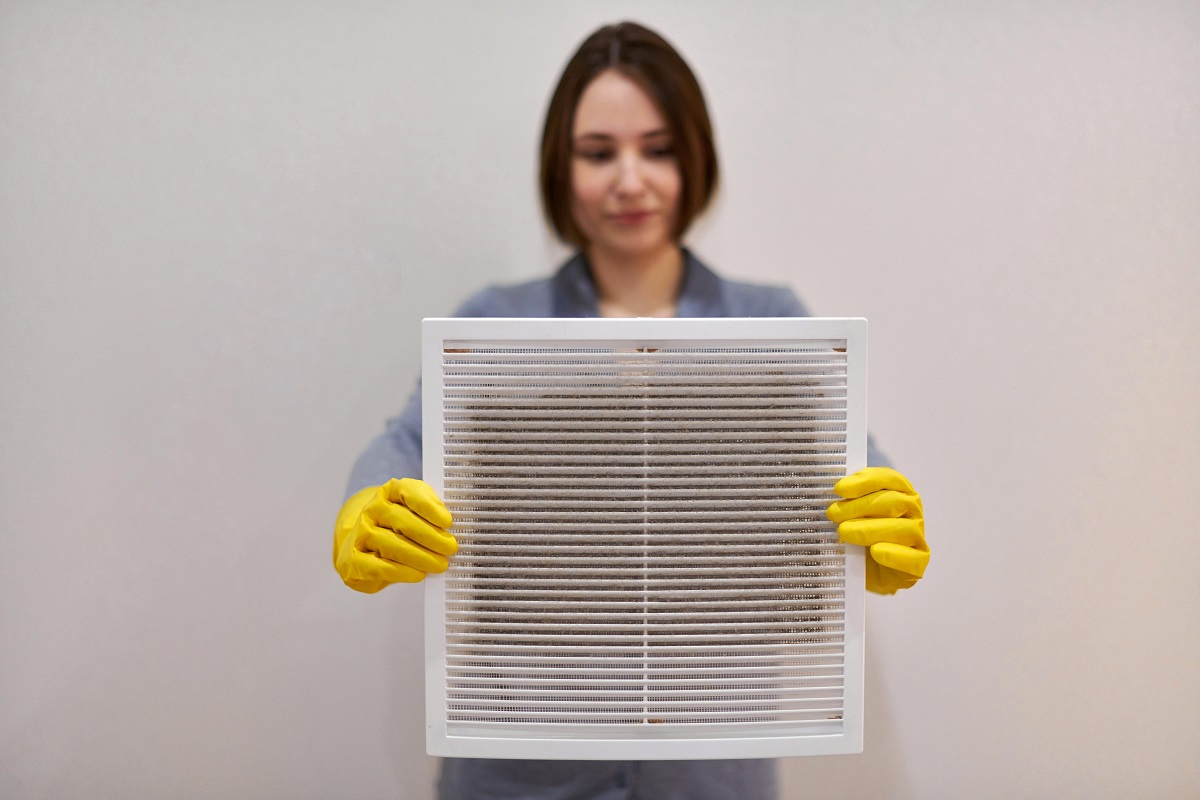A Musty Smell in Your Home? How to Identify the Source Now

How Do I Identify the Source of a Musty Smell in My Home?
Table of Contents
TL;DR: Key Takeaways
- A persistent odor is your home's signal of an underlying issue, most often excess moisture, which can lead to mold or mildew. Knowing how to identify the source of musty smell in home is the first step to a healthier living space.
- The main musty smell in house causes include hidden water leaks, high humidity, poor ventilation, and mold growth. A damp smell in house no visible mold is a critical sign of a hidden problem.
- What does mold smell like? It's often described as earthy, stale, or like damp, rotting wood, and it’s a key indicator of a moisture problem.
- To solve the issue, you must find the source. This involves checking common problem areas like basements, under sinks, and around windows. For a definitive answer, an indoor air quality assessment for odors is the most reliable method.
- Nestwell’s digital Healthy Home Score provides a science-backed, personalized action plan on how to get rid of musty smell in house by identifying the root environmental factors.
Why Does My House Smell Musty? An Introduction to Home Odors
That lingering, musty smell you can't quite place isn’t just unpleasant—it's your home's way of telling you something is wrong. You might notice it more when you first walk in the door after being outside, or perhaps it’s stronger in a specific room, like the basement or bathroom. This dank, old odor is a common problem, but it’s not one you should ignore. It’s a clear signal that there could be an issue with moisture and your indoor environment.
This guide will walk you through exactly how to identify the source of musty smell in home, understand the potential health implications, and discover actionable solutions you can implement today. A musty scent is more than just a nuisance; it points to conditions that can affect your family's well-being. By learning to pinpoint the origin of the smell, you are taking the first and most important step toward creating a safer, healthier living space.
We believe that everyone deserves to feel safe and healthy in their home. Your living space should be a sanctuary, free from worries about hidden problems. This guide provides the expert-backed information you need to take control of your environment, eliminate that unpleasant odor for good, and gain peace of mind. Let’s uncover what your home is trying to tell you.
What Are the Main Causes of a Musty Smell in a House?
To effectively eliminate a stale smell, you first need to understand where it comes from. The problem is almost always linked to moisture. When materials in your home get wet and stay wet, it creates the perfect breeding ground for fungi like mold and mildew. Below, we break down the top musty smell in house causes so you know what you’re up against.
Reason Why #1: Mold and Mildew Growth
The number one cause of a musty odor is the growth of mold and mildew. These are types of fungi that can grow almost anywhere there is moisture and an organic food source, like wood, drywall, carpet, or even dust. They thrive in dark, damp, and poorly ventilated areas of a home.
As mold and mildew grow and digest their food source, they release gases into the air. These gases are called microbial volatile organic compounds, or MVOCs. It is these MVOCs that you are smelling. The odor is a direct byproduct of the mold's life cycle. So, when you smell that musty scent, you are quite literally smelling the presence of active fungal growth. Finding this growth is key to stopping the odor.
Reason Why #2: What Does Mold Smell Like?
Many people struggle to describe the specific scent, so let's answer the question: what does mold smell like? The odor is very distinct and differs from the smell of simple dust or a cluttered room. The best way to describe it is earthy and damp.
Think of the smell of a forest floor after a heavy rain, with rotting leaves and damp soil. It can also be compared to the smell of wet socks left in a gym bag for a few days or a pile of damp cardboard. The scent is stale, pungent, and persistent. It clings to fabrics and seems to permeate the entire room. If you notice a smell that reminds you of damp, rotting wood or old, wet paper, you are very likely smelling mold. This earthy signature is a critical clue that a moisture problem exists somewhere nearby.
Reason Why #3: Water Damage and Trapped Moisture
A water damage musty odor is one of the most common ways these problems begin. Even a small, slow leak can create a big problem over time. Water can become trapped in hidden areas, saturating materials like drywall, insulation, and wood framing where you can't see it.
Common sources of this trapped moisture include:
- Slow Leaks: A tiny, dripping pipe under a sink or behind a washing machine can go unnoticed for months, slowly soaking the cabinet, wall, and floor.
- Roof and Window Leaks: After a storm, water can seep in around window frames or through a damaged roof, getting trapped inside walls or ceilings.
- Condensation: In homes with high humidity, condensation can form on cold surfaces like windows, metal pipes, or concrete basement walls. This constant dampness is enough to support mold growth.
- Past Flooding: If an area of your home, like a basement, has flooded in the past and wasn't dried out completely and immediately, moisture could still be trapped within the structure, leading to long-term odor issues.
Reason Why #4: Poor Ventilation and Air Quality
Finally, the issue can be made much worse by poor ventilation, which leads to a bad air quality musty smell. When air in your home is stagnant and doesn't circulate properly, it allows humidity to build up. Damp air is heavier than dry air, and it settles in certain areas, promoting the conditions for mold and mildew.
Homes that are sealed up tight for energy efficiency can sometimes suffer from this issue if they don't have a good ventilation system. Areas like bathrooms without an exhaust fan, or closets that are packed full with no airflow, become hotspots for stale, humid air. This lack of fresh air means that any MVOCs released by mold become concentrated, making the smell much more noticeable and persistent. Improving air circulation is a critical part of solving the odor problem.
Your Step-by-Step Guide: How to Find the Source of the Smell
Now that you know the likely causes, it’s time to play detective in your own home. Finding the exact origin of a musty smell can take some investigation, as the source is often hidden from plain sight. Follow this step-by-step checklist to systematically search your home and uncover the root of the problem.
Step 1: Look for Signs of Hidden Mold and Moisture
One of the most common frustrations is dealing with a damp smell in house no visible mold. Just because you cannot see large, dark patches of mold does not mean it isn't there. It is often growing behind walls, under flooring, or in other concealed areas. You need to look for the secondary clues that moisture and hidden mold leave behind.
Here are the key signs of hidden mold to search for:
- Peeling, Bubbling, or Cracking: Look closely at paint or wallpaper. Moisture in the wall behind it will cause the paint to bubble, crack, or peel away from the surface.
- Warped Materials: Water can cause wood materials to warp or buckle. Check baseboards, wood floorboards, and cabinet floors for any signs of bending or distortion.
- Discoloration and Stains: Look for faint, yellowish-brown stains on ceilings, walls, or around grout lines in your shower. These water stains indicate that moisture has been present, even if the area feels dry now.
- Persistent Condensation: Pay attention to windows or cold water pipes that frequently have condensation on them. This "sweating" is a sign of high humidity in that area, which can lead to mold growth on nearby surfaces over time.
- A Spongy Feeling: Gently press on drywall in areas that smell suspicious. If the wall feels soft or spongy, it is a strong indicator that the material inside is wet and possibly deteriorating.
Step 2: Investigate Common Problem Areas
Mold and moisture problems love to hide in specific places. Armed with your list of hidden signs, it’s time to inspect these common culprit locations, using both your eyes and your nose. The smell will almost always be strongest near its source.
Perform a room-by-room check, paying special attention to these areas:
- Basements & Crawl Spaces: These are often the dampest parts of a home. Shine a flashlight along the walls and check for dark spots or white, powdery residue on concrete, known as efflorescence. This residue is left behind as water evaporates, proving moisture has been passing through the walls. Sniff around corners and near the floor.
- Bathrooms & Kitchens: These rooms have a lot of plumbing. Open the cabinets under every sink and use a flashlight to look for drips, stains, or damp wood. Check the base of toilets and around bathtubs and showers for any soft spots in the floor or discolored caulk.
- Attics: After a rainstorm is a good time to check your attic. Look for signs of roof leaks, such as damp insulation or water stains on the wood of the roof deck. Poor attic ventilation can also trap hot, moist air, leading to issues.
- HVAC System and Vents: Your heating and cooling system can be a source of musty smells. Check the condensation drip pan near your indoor unit to ensure it is draining properly and not holding stagnant water. Also, get close to the air vents in different rooms and smell the air coming out. If the musty odor is stronger when the system is running, the problem could be in your ductwork.
- Laundry Rooms: Check the hoses connected to your washing machine for any leaks. Lint buildup behind the dryer can also trap moisture against the wall.
Step 3: Assess Your Home's Airflow
Poor airflow contributes directly to a bad air quality musty smell by trapping humid air. As you walk through your home, think about its ventilation. Answering these questions can help you determine if poor circulation is part of the problem.
- Are exhaust fans in the bathrooms being used every time someone showers or bathes? Are they left on for at least 20-30 minutes afterward to fully vent the moist air?
- How often are your HVAC air filters changed? A clogged filter restricts airflow through your entire home, reducing efficiency and allowing dust and contaminants to build up.
- Do some rooms or closets feel noticeably stuffy or humid compared to the rest of the house? These areas may need a dedicated solution, like a dehumidifier or simply leaving the door open more often to encourage air exchange.
By following these investigative steps, you are no longer just reacting to a bad smell. You are actively gathering clues to understand the environmental conditions in your home that are allowing it to happen.
Why This Matters: The Link Between Home Environmental Factors and Your Health
That musty odor is more than an annoyance; it’s a tangible symptom of broader home environmental factors smell that can impact your health. The smell itself is a warning sign that the air you are breathing contains byproducts from mold and mildew. Ignoring this signal means potentially exposing yourself and your family to an environment that could cause health issues.
Exposure to damp and moldy environments can be linked to a variety of health effects. For people with existing allergies or asthma, breathing in mold spores can trigger allergic reactions and asthma attacks. Common symptoms of a mold allergy include sneezing, a runny or stuffy nose, itchy eyes, and skin rashes.
Even for individuals without specific allergies, long-term exposure can lead to respiratory irritation. You might experience symptoms like a persistent cough, wheezing, or a feeling of tightness in your chest. These issues arise because your body is trying to fight off the foreign particles you are inhaling. Over time, this can put a strain on your respiratory system.
This is why Nestwell was founded. We believe that your home should be a healthy environment that supports your well-being, not one that secretly undermines it. We empower you with the knowledge to understand and improve these critical environmental factors. By connecting the dots between a musty smell and the underlying moisture issue, you can take proactive steps to clean your air, protect your health, and turn your home into a healthier space.
The Surest Solution: Using an Indoor Air Quality Assessment for Odors
Following your nose and looking for visible signs of moisture are excellent first steps, but they have their limits. The source of a leak can be far from where the damage appears, and mold can grow deep within structures where you can't see or smell it easily. Guesswork can only get you so far. For a definitive answer, an indoor air quality assessment for odors provides the data-driven clarity you need to solve the problem for good.
While traditional assessments require a specialist to come to your home, technology now offers a more convenient and comprehensive approach. Nestwell offers a revolutionary digital assessment that provides this clarity without an invasive in-person visit. We analyze hundreds of data points related to your specific property and location to build a complete picture of your home's environmental health.
How the Healthy Home Score Pinpoints Odor Issues
Our process is designed to be thorough yet simple. We use a powerful combination of information to get to the root of the problem. Your personalized report analyzes location-specific data, such as humidity levels and groundwater risks in your area. It also considers your home's unique characteristics, like its age and foundation type. We cross-reference this with authoritative environmental databases to identify potential vulnerabilities.
Your personalized report includes a healthy home score musty smell analysis. This targeted assessment identifies the specific factors in your home that are likely contributing to the problem. Instead of generic advice, you get insights tailored to your situation. For example, the report might flag high local humidity combined with a basement foundation as a major risk factor, pointing you directly toward the most probable cause.
The benefits of this modern approach are clear. The assessment is non-invasive, meaning no one has to enter your home. It’s backed by science, using data from trusted sources to ensure accuracy. Most importantly, it delivers a clear, actionable plan that tells you exactly what to do next. You move from worrying about a mysterious smell to confidently tackling the source with a prioritized list of solutions.
Your Action Plan: How to Get Rid of the Musty Smell in Your House for Good
Once you’ve identified the source of the moisture, you need a clear action plan. The only way to permanently eliminate a musty odor is to fix the underlying water issue and remove any resulting mold growth. This section outlines the type of prioritized recommendations you'll receive from Nestwell, giving you a powerful strategy for how to get rid of musty smell in house.
1. Control Moisture at the Source
This is the most critical step. If you don't stop the water, the problem will always return.
- Fix Leaks Immediately: Whether it's a dripping pipe, a leaky roof, or a cracked foundation, this must be your first priority. Repair any and all sources of water intrusion that your investigation uncovered.
- Use Dehumidifiers: In naturally damp areas like basements, crawl spaces, and even some bathrooms, a dehumidifier is your best friend. Run it consistently to keep the relative humidity below 50%, which makes it much harder for mold to grow.
- Grade Your Landscaping: Ensure the ground around your home's foundation slopes away from the house. This prevents rainwater from pooling against the walls and seeping into your basement or crawl space.
2. Improve Ventilation
Stagnant, damp air is a recipe for musty smells. Getting the air moving is essential for keeping your home dry and fresh.
- Use Exhaust Fans: Run the exhaust fans in your kitchen and bathrooms every time you cook or shower. Let them run for at least 20-30 minutes afterward to vent all the humid air outside.
- Install an Air Purifier: A high-quality air purifier with a HEPA filter is an excellent tool. It won't solve the moisture problem, but it will physically capture mold spores, dust, and other airborne particles, immediately improving your indoor air quality and reducing odors.
- Promote Cross-Ventilation: On dry, low-humidity days, open windows on opposite sides of the house to create a cross-breeze that flushes out stale, damp air.
3. Clean and Remediate
With the moisture and ventilation under control, the final step is to clean up any existing mold.
- Clean Small Areas: For small patches of surface mold (less than 10 square feet), you can handle the cleanup yourself. Use an appropriate cleaning solution and be sure to wear gloves and a mask to protect yourself.
- Seek Professional Help for Large Areas: If you have discovered a large amount of mold or suspect it is inside your walls, it is time to call a professional remediation service. They have the training and equipment to safely remove the mold and ensure it doesn't spread to other areas of your home.
The Nestwell Advantage: Tackling all these steps at once can feel overwhelming. A Nestwell report helps you prioritize. Based on our data analysis, your personalized Healthy Home Score report might tell you that investing in a high-capacity dehumidifier for your basement will have a greater immediate impact than any other single step, saving you time, money, and stress. It gives you the confidence that you are taking the most effective action first.
Frequently Asked Questions (FAQ)
Q: What is the most common cause of a musty smell in a house?
A: Among the various musty smell in house causes, the most common is mold or mildew growth from excess moisture or a hidden water leak. These fungi release gases that create the distinct earthy, stale odor as they grow in damp environments.
Q: I have a damp smell in my house but no visible mold. What should I do?
A: A damp smell in house no visible mold often indicates signs of hidden mold behind walls, under floors, or in your HVAC system. The best first step is to look for secondary signs like peeling paint, water stains, or warped wood. For a definitive answer, a comprehensive indoor air quality assessment for odors, like the digital one provided by Nestwell, is the best way to investigate further without demolition.
Q: Does bad air quality create a musty smell?
A: Yes, a bad air quality musty smell is a common problem. Poor ventilation and stagnant air trap moisture and airborne contaminants. This high humidity allows mold to thrive and lets the odors it produces become concentrated, contributing to a persistent, stale smell throughout the home.
Q: How can I permanently get rid of a musty smell in my house?
A: The only way to learn how to get rid of musty smell in house permanently is by addressing the root cause, which is almost always moisture. This involves fixing any leaks, improving ventilation to keep the air dry, and cleaning any existing mold. Your personalized Healthy Home Score report from Nestwell provides a prioritized, actionable plan to do just that.






